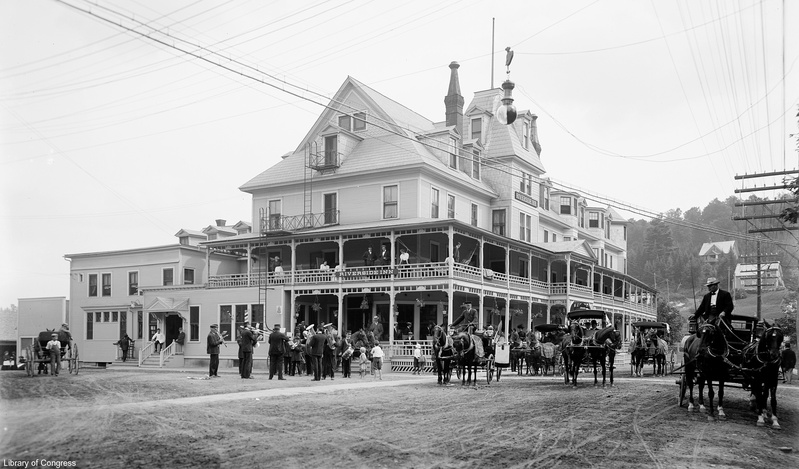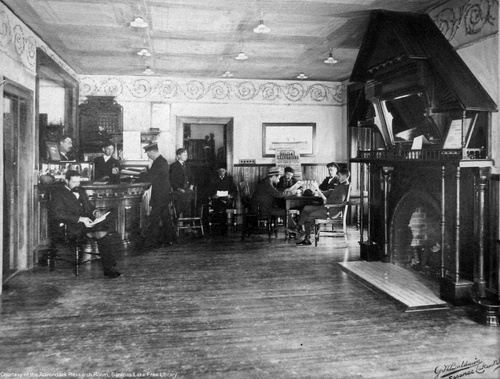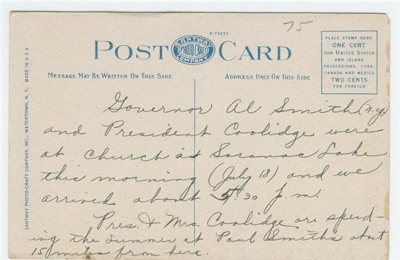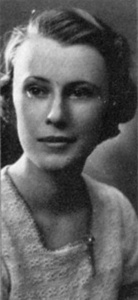
 Riverside Inn from Blood Hill, 1909. The buildings immediately to the right are two stables (livery), two wagon sheds, and a "gasoline garage", according to the 1908 Sanborn map. For the full photograph, see Saranac Lake Village, c. 1909
Riverside Inn from Blood Hill, 1909. The buildings immediately to the right are two stables (livery), two wagon sheds, and a "gasoline garage", according to the 1908 Sanborn map. For the full photograph, see Saranac Lake Village, c. 1909
Blood's Hotel, later called the Riverside Inn was the third hotel in the Village of Saranac Lake, opened in 1860, on the eve of the Civil War by Orlando Blood. Adirondack resorts prospered throughout the war, as men escaping the draft, and those who had paid others to take their places on the battlefield retreated to the mountains. 1
The Bloods had a hotel in Keene Center for several years but sold it in 1860 and moved to Saranac Lake. John J. Miller built the hotel, and Orlando Blood first leased it, and later bought it with eighty acres in 1865 for $2,115. This was the basis for his later wealth, for the hotel paid well, and the growth of the village began to make much of his land very valuable. He sold one acre on Main Street to guide Lucius Evans for one hundred dollars. This was such an unheard of price in those days that it caused amazement and comment throughout the community, and people drove in from miles around to gaze at the notorious acre.
Blood's hotel opened on a Fourth of July and he gave a ball for the occasion that exceeded anything that the village had seen before. More than one hundred couples were present, some of whom had driven from Malone, fifty miles away. The success of this ball led to others, and Blood's Hotel became renowned for this kind of social function.
Blood ran the hotel until 1883 and then leased it to Charles H. Kendall who kept it till 1886. It was then subleased to George A. Berkeley who ran it until his tragic death in 1888. According to an article in the Adirondack Daily Enterprise, "The Riverside Inn operated by Pine and Corbett was the gem of old Main Street with 61 bedrooms, exclusive of those occupied by family and servants. Mark Twain occasionally sat on the shaded veranda. The dining room could seat 130, a large accommodation for the time." 2 The Riverside Inn was torn down in the 1930s.
Blood's Hill, southwest of the hotel, was part of his holdings; it was later used for ski jumping.
Sources:
- Donaldson, Alfred L. A History of the Adirondacks, New York: The Century Co., 1921, pp. 233, 4. (reprinted by Purple Mountain Press, Fleischmanns, NY, 1992.
 The land that would soon be Riverside Park is seen on October 12, 1935, after the Riverside Hotel was demolished.
The land that would soon be Riverside Park is seen on October 12, 1935, after the Riverside Hotel was demolished.
Adirondack Enterprise, April 10, 2010 Adirondack Enterprise, February 4, 1915
Adirondack Enterprise, February 4, 1915  Riverside Inn postcard, 1908.
Riverside Inn postcard, 1908.
Santway Photo-Craft Co., Inc., Watertown
 Riverside Inn postcard, 1914
Riverside Inn postcard, 1914  Riverside Inn, 1887. The photograph is signed by George Baldwin. Courtesy of Nora Bouvier
Riverside Inn, 1887. The photograph is signed by George Baldwin. Courtesy of Nora Bouvier  Riverside Inn, undated. Note the difference in the floor and ceiling treatments. Adirondack Daily Enterprise, February 12, 2011
Riverside Inn, undated. Note the difference in the floor and ceiling treatments. Adirondack Daily Enterprise, February 12, 2011  Riverside Inn, 1898 by George Baldwin
Riverside Inn, 1898 by George Baldwin  Riverside Inn postcard, private collection, 2009.
Riverside Inn postcard, private collection, 2009.  Riverside Inn postcard message, 1926. Private collection, 20
Riverside Inn postcard message, 1926. Private collection, 20
 Adirondack Daily Enterprise, April 29, 1989
Adirondack Daily Enterprise, April 29, 1989
From Blood's to Riverside, this hotel thrived
Recent articles in this series recalling the passing of some of our fondly remembered local hotels seems to have generated a good deal of interest. In keeping with this trend, we must surely include the Riverside Inn to take its rightful place among our famous hostelries of yesteryears. Its history not only goes back to the very origin of our village but for over 70 years it served as a most popular center of activity in the North Country. Many of our senior citizens, who were not overnight guests at the hotel, were still regular customers at the barber shop, the pool parlor, the barroom, or the dining room and some came just to enjoy a seat of observation on the spacious verandah. Located next door to Lake Flower and the Main St. bridge, the hotel commanded a prominent and advantageous location.
The first hotel on the site was built by John J. Miller, a son of Capt. Pliny Miller, but the place never really caught on. In 1865 Miller sold out to Orlando Blood for $2,115, which price included 80 acres of land. Blood, like his contemporary Paul Smith, was a born hotel keeper with keen business acumen and a genial personality. "Lon" Blood opened his hotel on the 4th of July, 1865 with an extravagant ball that was attended by over 100 couples. This was only the forerunner of many such gala affairs that brought fame and financial success to the establishment for 18 years. During this period, the place was simply known as "Blood's." Old timers still call Lake Street Blood's Hill. Another application of his name, however, did not survive. Lon owned many valuable building lots along Main St., part of his original 80 acres, which he sold for considerable profit during the post-Civil War boom. Because of his prominence and popularity, many of his followers tried to christen the settlement "Bloodville." Perhaps we can be thankful that the name never made it! Other attempts were made to call the village "Trudeau" for Dr. E.L. Trudeau and "Baker's" for Col. Milote Baker, another innkeeper.
Blood sold the hotel to Charles Kendall in 1883 who in turn leased it to George Berkeley three years later. It was here, in 1888; that Berkeley was shot and killed by Charles Brown, as reported in an earlier article. After Berkeley's death, the hotel was acquired by Wallace Murray who changed the name of the place to the Riverside Inn and greatly enlarged the building.
Known as "Wal" to his many friends, Murray was very like Orlando Blood. He was every bit as shrewd a business man and was also extremely well liked in the community. He had been a guide and a lumberman before purchasing the hotel and these prior pursuits afforded him a well-rounded knowledge of the area and the people.
Six years after he bought the hotel, he teamed up with Blood to form the Saranac Lake Electric Company and bring electric service to the village. The company purchased the Steve Merchant sawmill and converted the water powered plant to a hydro-electric generating station. Murray then entered into; politics and served two terms as village president. The Riverside Inn continued to expand until it reached four stories high and filled the entire block between River Street and the Main Street bridge. With its two-tiered wrap-around porch it made an impressive structure. The dining room boasted an extensive menu which attracted guests from as far away as Malone to savor the house specialties. Appetizers featured such delicacies as blue point oysters, artichokes, or Kennebec salmon. Green turtle soup would lead to such entrees as lobster, broiled squab, breast of bear, or Egyptian Quail on toast. For dessert one could select Charlotte Ruse, peach trifle, orange meringue pie, or fruit pudding with brandy sauce. The Waldorf had nothing on the Riverside!
Wal Murray was a true entrepreneur. In the 1906 village directory his occupation was listed as "speculator." He was on good terms with Governor Roswell P. Flower and was instrumental in the naming of Lake Flower in honor of the Governor. He was also quite generous and many residents "hard up against it" knew where to go for a loan.
As popular as its proprietor was, the Inn was even more so. Guests arrived from all points of the U.S. and Canada, with some coming from as far away as London, England. The register for 1895 proves that the Riverside was a gathering place for local businessmen. Perhaps the greatest compliment to a hotel's reputation is established when rival managers choose to patronize the place. Many came to the Riverside. On April 18, 1885 Melvil Dewey signed in from Albany in search of a site for his "Club."
Visiting theatrical casts also seemed to prefer the Riverside. Lucier's Minstrels checked in on Nov. 20, 1895, with a cast of 15. On Jan. 4, 1896, Stenson's "Uncle Hiram Company" took rooms for a cast of 12 actors and, on March 10, Salambo & Ollivette's "New Wonders" checked in with, Professor Powell for dinner and a one-night stand.
In 1899, Wal Murray decided to retire, so he built his home on the site of a former hotel, the once famous "Baker's," which stood next to the Pine Street bridge. Col. Baker's son, Andrew, played host to Robert Louis Stevenson during the winter of 1887-88 in his nearby cottage which remains today as an R.L.S. memorial.
The new owners of the Riverside, John Corbett and Euclid Pine, took over at the turn of the century with a policy to continue the pattern of operation as established by Murray. Pine had considerable experience in hotel administration, having served his internship at both Paul Smith's and Saranac Inn. The Riverside, under the partnership of Pine and Corbett, was destined to enjoy many years of prosperity. Their published advertisement for the year 1906 boasted "The largest and best appointed all-year-round hotel in the Adirondacks. Thirty of our rooms have private baths."
John Corbett died in 1911 and Pine continued to operate the Inn. Salesmen from the larger city firms, together with sportsmen and their guides, made up the majority of the clientele. These were flourishing pre-war and post-war years of World War I in the village and the Riverside Inn was riding its final wave of prosperity. Soon to follow, however, was the general decline in the older wood-frame Adirondack hotels. Many had suffered from fires while others yielded to the wrecker's axe. The most famous of all Adirondack hotels, Paul Smith's, was burned to the ground in 1930. Time was running out for the Riverside Inn. Not only was the great depression reaching our area but also the glory days of Winter Carnivals and International Speed Skating Races were on the wane.
On October 15, 1934, Euclide C. Pine closed the doors of the Riverside Inn. 3 Newspapers carried such stories as: "The closing of the Riverside Inn, which was announced this week, probably will end the history of one of the most famous hostelries in the Adirondacks. It was the first public house in Saranac Lake and always has been identified prominently with the history of the village."
The furnishings were sold off as the walls were going down and many a cherished souvenir found its way into community homes. The venerable old mahogany bar from the taproom finally wound up just across River St. in the Spaulding building where it continued to serve up potables dispensed by Dick De Santis in the Riverside Bar & Grill.
Euclide Pine lived for some 15 years after his retirement. He was active in village affairs, served as a director of the Adirondack National Bank, a member of the Water Board, and also was elected to the Franklin County Board of Supervisors. He died in Plattsburgh in 1947 at the age of 80. He had previously sold the hotel property to the village and the site remains as a public park.
The final phase in this sequence of events took place in March, 1955, when the Spaulding Block was razed to make room for a Texaco station. The historic old bar was moved to the Floyd-Jones Camp on Lower Saranac Lake where it enjoys a well-earned retirement.
New York Times, June 27, 1897 (A pdf of the full article is here)
ON MOUNTAINS AND LAKES
The Numerous Adirondack Resorts Now Ready to Receive the Summer Visitor.
...The Riverside Inn at Saranac Lake will be managed this season by Wallace Murray, who succeeds Mr. Watson, the latter having taken charge of the Chazy Lake Hotel, on the Chateaugay Railroad...
 Postcard of the Riverside Inn from the Saranac River, with the clock tower of the old Harrietstown Town Hall showing to the right.
Postcard of the Riverside Inn from the Saranac River, with the clock tower of the old Harrietstown Town Hall showing to the right.
The area is now Riverside Park. Colorized but with color removed. Postmarked June 23, 1910.
Historic Saranac Lake collection, #2021.3.91. Gift of the Florence Wright Tuberculosis Postcard Collection.
Brooklyn Daily Eagle, June, 25 1899
The Riverside Inn is a new hotel recently built and in many respects is not surpassed in the mountains. It is situated near the Saranac River, where boating is indulged in at all times during the summer, and the steamer which conveys pleasure seekers up and down the river lands but a few rods from the house. It is in the center of the village and convenient to post office, churches and stores. A good livery is connected with the establishment and a free bus connects with all trains. The Riverside has accommodations for seventy-five guests and is managed by Wallace Murray.
Plattsburgh Republican, November 3, 1899
The Riverside Inn
Arrangements have practically been made for the sale of the Riverside Inn, the well-known Saranac Lake hotel, to John Corbett, of Fort Edward, and E. C. Pine, of Ausable Forks. The present owner, Wallace Murray, will manage the Saranac Lake Electric Light Company, in which he is a large stockholder.
Mr. Corbett has been bartender at Paul Smith's and Mr. Pine has been clerk at Paul Smith's and Saranac Inn for many years. Both are experienced hotel men, and the house, under their management, will maintain its reputation as an excellent hostelry.
Plattsburgh Republican, November 11, 1899
Euclid C. Pine and John Corbett have purchased the Riverside Inn property at Saranac Lake for about $30,000.
Malone Palladium, October 17, 1901
E. C. PINE and JOHN CORBETT, who recently purchased the Riverside Inn at Saranac Lake, and who have made it during the summer one of the very best hotels in Northern New York, have now in contemplation an enlargement of the building, which will about double its capacity. It contains at present 38 sleeping rooms, and their plan is to add 32 more. Both Mr. PINE and Mr. CORBETT gained their hotel experience at the famous establishment of PAUL SMITH, and in knowledge and individual characteristics are excellently adapted to the business. Saranac Lake is a peculiarly good hotel town, and the Riverside enjoys, as it deserves, a fine reputation.
Seneca Ray Stoddard's 1908 The Adirondacks, Illustrated
The Riverside Inn faces the main street of the village, its east front looking out on Lake Flower to which the hotel grounds extend. Pine & Corbett, proprietors. The Inn is modern, attractive and handsomely equipped. It has piazzas extending along the front and around to face the lake, with cosy corners for shelter and broad spaces for sun and wind. It is fitted throughout with electric lights and bells. The plumbing is modern and sanitation is believed to be perfect. It has hardwood floors and rugs are used instead of carpets. Bath rooms have floors and side walls of white tiling. Bed rooms have large closets and all have outside views. Of the 70 rooms, 30 are en suite with private baths. It also has one suite consisting of private parlor, dining room and three sleeping rooms with two baths on the main floor. Billiard and pool rooms have electric fans. The house will accommodate 120. The dining room has capacity for 125. The table is superior and served daintily. Rates $2.50 to $4 per day. Per week $15 to $28. Open all the year.
Adirondack Record, January 19, 1917
[Excerpt from the obituary of Augustine S. Branch]
...The death of Mr. Branch recalls to old residents of Saranac Lake Mr. Branch's first contract there, the construction of the Riverside Inn. The interesting history of hotels on that site is also recalled.
The original hotel, the Miller House, of which the late John J. Miller was proprietor, was the first hotel in Saranac Lake and one of the first in the Adirondacks. It was that portion of the house now used as servants' quarters, the kitchen, dining room and buffet.
Mr. Miller sold the hotel to the late Orlando Blood, who renamed it the Blood House. After a number of years. Mr. Blood. sold the house to the late Charles Kendall, who called it the Riverside Inn. After several years Mr. Kendall sold the house to George Berkeley, who was shot to death on his veranda, at which time the house again came into the possession of Blood. Berkeley called it the Adirondack House.
When Mr. Branch went to Saranac Lake in 1891, as a small contractor, Mr. Blood was in ownership of the hotel with Wallace Murray also having half interest. Mr. Branch received the contract to build the hotel as it now stands with the exception of the wing running to the edge of Lake Flower. His establishment was situated at that time just to the rear of where the village offices are today. Mr: Murray re-named the hotel the; Riverside Inn, which name it still carried when Pine & Corbett came from Paul Smiths and took it over in 1900. Seven years after their arrival they completed the structure as it now stands.
Lake Placid News, June 8, 1934
RIVERSIDE INN PASSES AS AD'K LAND MARK
Furnishings Sold and Hotel Dismantled
With the dismantling of the Riverside Inn at Saranac Lake and the sale of its furnishings the passing of yet another landmark of other days of the Adirondacks will he mourned by those old residents who recall the days when it was one of the flourishing hotels of the north country.
The decision to commence a gradual liquidation of the property was arrived at by E. C. Pine, the owner, after many months' deliberation. Furnishings are gradually being sold.
The first, and possibly the most significant of the fixtures to go was the old bar, which had seen so many years of service before the cause of prohibition rang down the curtain on its hospitable services. It will renew its duties in the Club restaurant.
Riverside Inn has long been associated with the development of the Adirondacks, being first known as "Blood's Hotel," owned at that time by an Adirondack pioneer, Orlando Blood.
The building was built by John J. Miller, and Blood leased it in 1865 for the sum of $2,115. At that time the property was much smaller than it is now, numerous additions having since been built.
The hotel had its opening on the Fourth of July, with a ball which outclasses anything that Saranac Lake had ever seen before. A crowd of more than 200 persons attended, some even driving from the distant city of Malone—a rare feat of travel for those days.
 1932 Canaras: Carolyn Pennington Smith; "Carrie"; Riverside Inn; Junior Prom Committee (3); Canaras (3, 4); Red and White (3, 4); Our Book (1); "Sailor Maids" (3); State Band Contest (2, 3); Band (1, 2, 3, 4); Orchestra (1, 2, 3, 4); Girls' Glee Club (2, 3, 4); Latin Play (2).
1932 Canaras: Carolyn Pennington Smith; "Carrie"; Riverside Inn; Junior Prom Committee (3); Canaras (3, 4); Red and White (3, 4); Our Book (1); "Sailor Maids" (3); State Band Contest (2, 3); Band (1, 2, 3, 4); Orchestra (1, 2, 3, 4); Girls' Glee Club (2, 3, 4); Latin Play (2).
Blood ran the hotel until 1888, when he leased it to Charles H. Kendall, who kept it until 1886. It was then subleased to George A. Berkeley who ran it until his death in 1888.
Shortly afterward the hotel passed into the hands of another pioneer of Adirondack history — Wallace Murray. The name "Blood's Hotel" was changed to "Riverside Inn" and sold to Pine and Corbett in 1899. Mr. Corbett died in 1911, but Mr. Pine still retained an interest in the business.
Watertown Daily Times, 1948 4
FOURTH OF JULY CELEBRATION—Two squads of the Woodruff Hose company stage a drill for the spectators of Saranac Lake on July 4, 1897. The photograph taken from the second floor porch of the now-demolished Riverside Inn by the village's veteran photographer, George W. Baldwin, was among the historical photographs left by the late photographer.
Each year the fire departments of Saranac Lake, consisting of the Woodruff and Miller Hose companies would parade and execute drills in the village. On most years races would be held with companies from neighboring villages and for many years the combined Saranac Lake hose companies were undisputed champions in the area.
Some of the departments they met and defeated in the latter part of the last century and the beginning of the 1900's included the Lafayette company from Plattsburgh, [illegible] from Burlington and companies from Miller hose company which was formed in January, 1893, relates an account of one Fourth of July when his team traveled to Tupper Lake to race Tupper Lake's team for $125. According to the judge, the fame of the local group was such that the Tupper Lake aggregation declined to race and the Miller hose company was awarded the $125 on default.
The brick building on the right of the picture was the first brick building built in the village and still stands, untouched by modernity. It was on the steps of this building that Charles Brown, a local guide, waited for George A. Berkeley, manager of the Rjverside Inn, and shot and killed the inn manager when he walked out the door to the street. The killing occurred in 1888 but the whereabouts of Brown was never discovered.
On the left is the "old town hall" which was destroyed by fire in 1926. It has since been replaced by a modern town hall. [illegible]
Comments
Footnotes
1. John J. Duquette,'"The Saranac Lake House," Adirondack Daily Enterprise, August 13, 1986.
2. "In 1911 Saranac Lake was a Hotel town", Adirondack Daily Enterprise, March 17, 1966
3. The April 12, 1935 Lake Placid News reported the date as September 11, 1933
4. For more information on this photograph and caption, see Old Saranac Lake photographs




